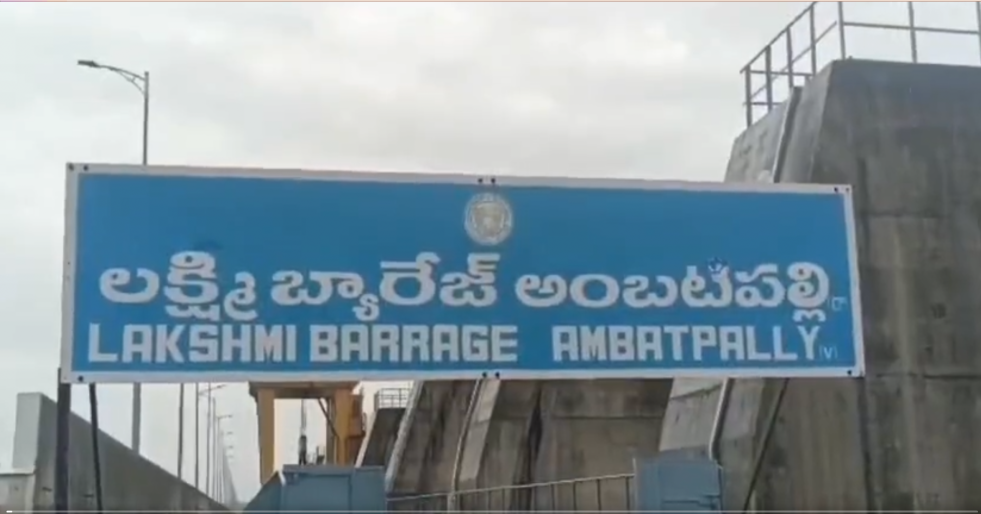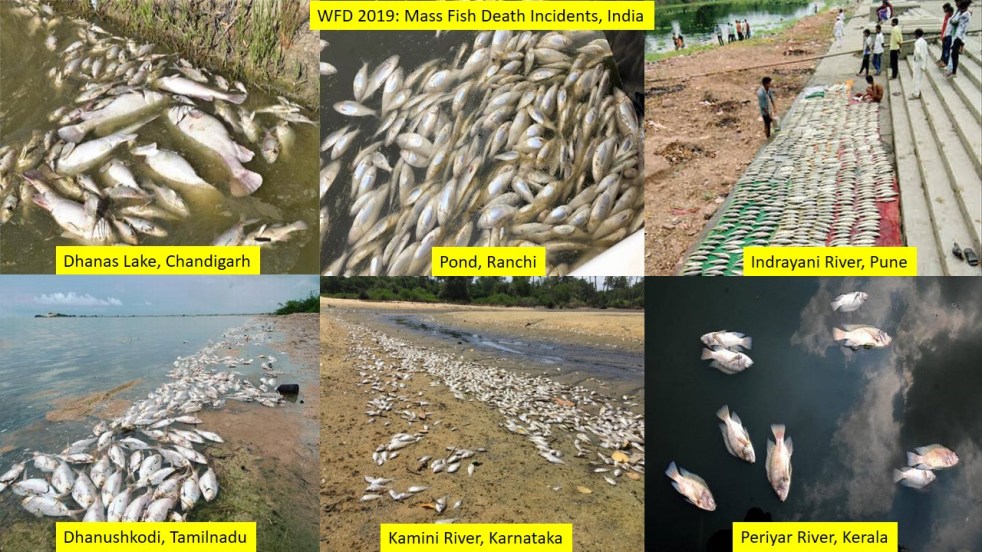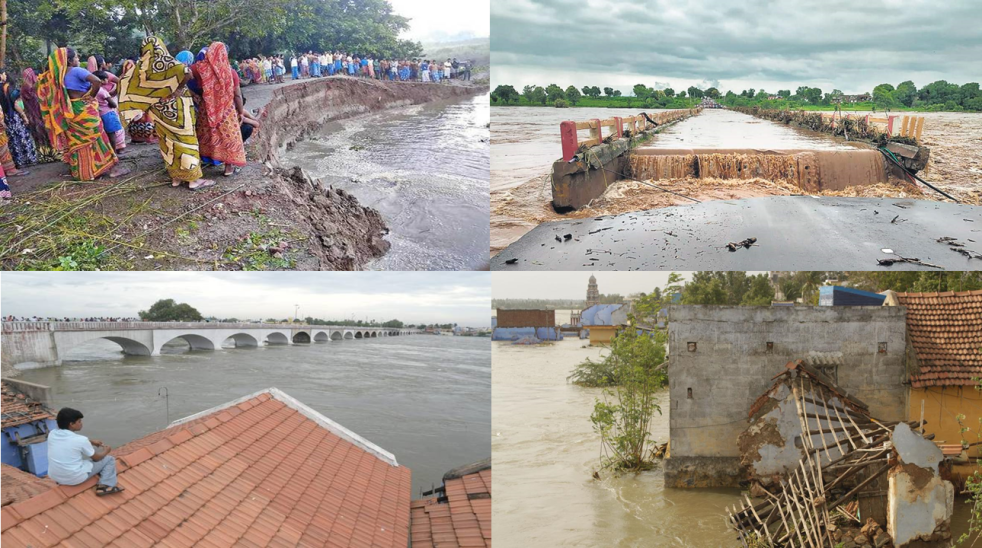A portion of the Lakshmi (Medigadda) barrage on Godavari river on Telangana-Maharashtra border, part of the Kaleshwaram Lift Irrigation Project (KLIP) in Telangana’s Jayashankar Bhupalpally district[i] caved in on Oct 21 2023, Saturday night with a loud sound. The incident led to the temporary closure of the bridge of the barrage across the Godavari River that links Telangana’s Mahadevpur mandal with Maharashtra’s Gadchiroli district. The KLIP is the world’s largest Lift Irrigation Project, possibly the costliest, with expenses already above Rs 1 lakh crore. The Union Govt, recognising this as a major dam failure under para 8 of Schedule II of Dam Safety Act 2021, has promptly sent a team of six experts to assess the damage.
Continue reading “Medigadda dam of Kaleshwaram project in Telangana damaged in Oct 2023”Tag: Godavari River
2022: When Polavaram project further unraveled
(Feature Image: Flood water discharging from Polavaram Project to the downstream, in West Godavari district, on Jyly 12, 2022. The Hindu)
Polavaram is the largest and costliest big dam project under construction in India currently, though not much has been written about this projects and its impacts in mainstream in India. The project was given various clearances through a manipulated process, basic studies were not done before clearing it. Several petitions are pending before the various High Courts and the Supreme Court of India, but the project is allowed to go ahead without resolving them or the inter-state issues. A number of issues related to the project has been unravelling over the years and in 2022, the project further unraveled as the news reports compiled here reveal.
A snapshot of the status at Polavaram Project: The downstream coffer dam is damaged, the Gap 1 and Gap 2 of the Dam are yet to be constructed, the 1.7 km long Diaphragm wall of the ECRF dam is submerged in flood waters, it was earlier damaged (scoured at two places over an an area of 200 m X 200 m) in 2019 floods implying additional expenditure of Rs 600 cr, the water flow at the dam site on July 15, 2022 was highest since 1920 for July, the assessment of the earlier damage to the diaphragm wall and future options that was underway when the floods struck in the second week of July 2022, had to be stopped while still incomplete, the rehabilitation colonies have been submerged as the engineers assessment proved wrong about their elevation. There is an uncertainty on the structural stability of the other facilities of the irrigation project due to incomplete construction of the main dam, as it is receiving an unprecedented inflow. The height of the upper Coffer dam was increased by 1 m to 44 m between 17 and 19 July, 2022, in the middle of high floods, but that had impact on upstream Telangana and they opposed that this was done without consulting them.
Continue reading “2022: When Polavaram project further unraveled”DRP NB 2 Nov. 2020: Citizen Efforts to Save our Rivers
It’s heartening to see at least three citizen efforts that media has brought to limelight this week, two in Odisha and one from the banks of Godavari river in Nasik. Besides being citizen efforts, one common theme is that all these initiatives is that they concern rivers. Great news to celebrate in this festival season, also when India Rivers Week is also conducting weekly Dialogues on River sand mining.
Continue reading “DRP NB 2 Nov. 2020: Citizen Efforts to Save our Rivers”DRP NB 12 Oct 2020: Why is India’s flood forecasting system ineffective?
This scholarly article shows why India’s flood forecasting system is ineffective. It is not location specific, provides too short a time, it does not provide the intensity of flooding, it is not comprehensive, there is no independent assessment. As far as dams are concerned, its performance is worst, and is unable to either expose wrong dam operations or take action against such operations. Its inflow forecasts are most of the time non existent. It makes numerous errors, but fails to correct them for long time. Its website is slow, sometimes totally non functional. It keeps changing the monitoring sites, their HFLs and provides neither consistency nor reasoning for many of its actions. In the middle of the monsoon it decided to curtail the hydrographs and information display system. Read on.
Continue reading “DRP NB 12 Oct 2020: Why is India’s flood forecasting system ineffective?”DRP NB 30 Dec. 2019: Attention of Groundwater is much needed, but will ABY help?
Groundwater is India’s water lifeline for some decades and will remain so. So attention to Atal Bhujal Yojana (ABY) is welcome, but key question is, will it help sustain our Water Lifeline? The World Bank funded project ABY has been in limbo for several years, but for some unknown reasons, took years to enter implementation phase. Secondly, why did it need the World Bank funding and how that will help for a scheme that essentially needs bottom up regulatory system, where the global banker has far from confidence inspiring track record?
Groundwater sustainability requires: 1. Identifying, understanding existing groundwater recharge systems 2. Protecting such recharge systems. 3. Enhance recharge from such systems. 4. Create additional recharge systems 5. Acknowledging in National Water Policy, programs and practices that Groundwater is India’s water lifeline and most importantly 6. Creating a bottom up legally empowered groundwater regulatory system.
Continue reading “DRP NB 30 Dec. 2019: Attention of Groundwater is much needed, but will ABY help?”
WFD 2019: Mass Fish Kill Incidents Due to Pollution, Dry Rivers In India
21 November is celebrated as world fisheries day across the world. Apart from crucial source of food and livelihood to lakhs of fisherfolks in India, fish diversity determines the health of the water body including lakes, ponds and rivers. However with growing threats and pollution mass fish mortality has been taking place in various rivers and lakes in the country every year. On World Fisheries Day 2019 SANDRP has put together known mass fish kill incidents that took place this past year to highlight the gravity of threat so that corrective measures can be taken by respective Governments and others concerned.
Continue reading “WFD 2019: Mass Fish Kill Incidents Due to Pollution, Dry Rivers In India”
South India Overview of CWC Flood Forecasting Sites 2019
Flood Forecasting (FF) is one of the important activities of Central Water Commission (CWC), which is undergoing expansion and improvement, but there is still a huge scope for improvement. In order to better understand the CWC’s flood monitoring and forecasting work, in this article, we have given an overview of CWC’s flood forecasting and monitoring sites in South India, the last region to be covered for 2019 flood season. It includes state wise list of CWC’s Level Forecast, Inflow Forecast and level monitoring sites in South Indian states of Andhra Pradesh, Telangana, Karnataka, Tamil Nadu, Puducherry (no FF sites) and Kerala. Similar report has been published for North India[i] and North East India[ii], East India[iii] and West India[iv]. Continue reading “South India Overview of CWC Flood Forecasting Sites 2019”
Dams Floods 2018: Filling up Dams well before Monsoon end, Invitation to Disaster
The tendency of filling up reservoirs in the beginning and middle of monsoon season have been leading to avoidable flood disasters in the country. Apart from Kerala flood 2018, which was aggravated by mismanagement of reservoirs, various reports show that reservoirs in river basin of Cauvery, Krishna, Godavari and Ganga were also filled up well before the end of South West monsoon season. Resultantly there were many man made flood spells in downstream areas affecting lives and livelihoods of people.
After highlighting role of dams in floods in Kerala and how improper dam operation affected people in Assam and Himachal Pradesh, this third and concluding part throws light on other dam induced flood (and canal breach) incidents in 2018. Continue reading “Dams Floods 2018: Filling up Dams well before Monsoon end, Invitation to Disaster”
South India Rivers Review 2017: More Water for Cities from Drying Rivers
This fourth rivers review presents developments related to rivers in States of South India including Telangana, Andhra Pradesh, Karnataka.
Telangana Rivers 2017
Manair River Garbage polluting Manair river The shores are being polluted by the Municipal Corp of Karimnagar (MCK), which is dumping garbage generated from the town. Other private agencies such as chicken centres, hotels, private hospitals, mechanical shops and others too are also dumping garbage generated at their places into the river Manair. The State Govt had decided to develop the Manair front on the lines of Sabarmati river front development, which would spell further disaster for the river. http://www.thehindu.com/news/national/telangana/Garbage-polluting-Manair-river/article17113713.ece (The Hindu, 30 Jan. 2017)
Continue reading “South India Rivers Review 2017: More Water for Cities from Drying Rivers”
Maharashtra Rivers Review 2017: Multi-colored Rivers!
About Rivers Pollution and Pollution Control Board
Highest number of polluted rivers Maharashtra state has 49 polluted river stretches, highest in the country, which including Mithi, Ulhas, Vaitarna, Godavari, Bhima, Krishna, Tapi, Kundalika, Panchganga, Mula-Mutha, Pelhar and Penganga. 3,000 MLD of untreated sewage and industrial effluents are discharged into the state’s water bodies daily. http://www.hindustantimes.com/mumbai-news/pollution-in-three-maharashtra-rivers-is-nine-times-permissible-limit/story-RCuTrl8zi8tmFoOvgKR2zI.html(Hindustan Times, 16 Nov. 2017)
According to a report by Union Environment Ministry, Maharashtra generates about 8,143 Million Liter per Day (MLD) which is almost 13 per cent of the country’s sewage, butclaims to treats 5,160.36 MLD.In this way Maharashtra is releasing at least 3000 MLD untreated sewage in rivers, creeks and wetlands areas. http://www.hindustantimes.com/mumbai-news/834-factories-across-maharashtra-shut-down-in-2-years-for-causing-pollution-mpcb/story-MrmmXa9XH9Vdkzu2wKSdcL.html (Hindustan Times, 22 Dec 2017)
Continue reading “Maharashtra Rivers Review 2017: Multi-colored Rivers!”









